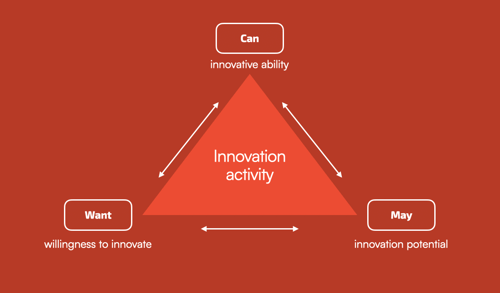What is innovation culture?
Innovations can only develop in a culture of innovation that promotes creativity. In this article you can read exactly what innovation culture is and which factors are indispensable for successful innovation activity.

Innovation culture – meaning
The culture of a company determines the relationships and actions of its employees within the company and shapes its external appearance. It is not openly visible, but shows itself indirectly through values, norms, attitudes and paradigms that employees share collectively.
Definition: innovation culture
The culture of innovation, on the other hand, describes a specific form of corporate culture that is primarily intended to promote the development of innovations within the company. Since innovation processes are generally cross-divisional processes, the innovation culture functions as a kind of cross-cutting culture, whose standards and values are shaped and supported by all process participants. A positive innovation culture creates incentives for employees and leads to an increase in the innovative strength of the company.
The three dimensions of innovation culture
Innovation activity in the company is to a large extent determined by an innovation-promoting culture that encompasses both "ability" (innovative ability), "willingness" (willingness to innovate) and "may" (innovation potential).

The three dimensions do not stand alone, but influence each other. For example, willingness to innovate is very strongly influenced by the other two dimensions of innovative ability and opportunity. A change in one of the dimensions automatically results in changes in other areas. Ideas can therefore only be efficiently developed into innovations once the framework conditions for ability, will and privilege have been created.
1. Ability - innovative ability
In order to generate ideas and turn them into sustainable innovations, employees must be supported and promoted in developing and unfolding their creative potential. This requires, on the one hand, innovation-promoting management and, on the other hand, increasing the innovative ability of employees through the development of specialist knowledge:
- Make innovation culture a top priority and establish top-down processes throughout the company
- Training of employees in modern methods and tools for brainstorming, idea evaluation and idea realization (innovation crash course, creativity techniques, innovation management)
- Trend and future workshops
- Development of the technical, technological and economic knowledge of employees
- Cross-departmental and cross-divisional innovation workshops with moderation by an external innovation consultant
- Internal knowledge transfer through transfer of newly acquired or already existing knowledge in internal training courses
- Use of external know-how and an open innovation approach (cooperation with universities, research institutions, other companies, external innovation consultants; Internet research and specialist literature; expert interviews, patent research)
- Use of new techniques and technologies
Creativity is not a privilege for individuals, but an ability that all people possess. Prejudices in this regard and a lack of knowledge of innovation methods very often inhibit the innovative ability of employees. Time pressure and stress that make it difficult to think beyond the daily business are also inhibiting for "ability".
2. Willingness - willingness to innovate
Innovative action cannot be ordered. It must be intrinsically motivated in order to establish a lasting culture of innovation in the company. This means that committed and imaginative employees are needed in the company, who are also willing to leave the usual paths of thinking and acting in order to develop an innovation from an idea. Motivated managers and the development of an innovation culture increase the willingness to innovate:
- Raising awareness of the importance of innovation in companies (communication and awareness-raising training, annual Innovation Day)
- Openness to employees' ideas (e.g. gathering employees' ideas in a "ideas box" and joint idea evaluation)
- Encouraging change and risk taking by establishing a climate of innovation in which employees can make mistakes and learn from them
- Creation of motivation through incentives and appreciation of innovation contributions (bonuses, career perspectives, gifts in kind, pitching contests, innovation contests, praise and recognition)
- Review and change of the role understanding of superiors within the framework of the creative process (boss becomes moderator and coach)
The "willingness" is also positively influenced by the increase in the ability to innovate, since employees are more self-confident, more willing to take risks and more motivated to approach an innovation. In addition to "ability", however, motivated employees also need "permission".
3. May - Opportunity for innovation
Permission is the necessary prerequisite for actually moving from "ability" and "will" to action. Within a company, therefore, framework conditions must be created that offer employees the opportunity to think and act innovatively and creatively.
- Creation of time resources by making part of the working time available to employees for the implementation of promising ideas.
- Creation of financial resources by providing an innovation budget
- Definition of clear goals, responsibilities and competencies and processes with regard to the development and implementation of ideas
- Ensuring fast and efficient communication across all hierarchical levels and the creation of free space for informal communication (e.g. break rooms)
- Fast and effective decision-making structures
- Formation of cross-divisional creative teams for the joint development of ideas
- Involvement of employees in the innovation process right from the start (cross-divisional and cross-hierarchy project teams, cascade workshops)
- Promotion of personal initiative and entrepreneurial action by conveying confidence in the willingness to perform, the commitment and the performance of the employees
If the "may" is combined with numerous hedging loops in the hierarchy, then this very quickly slows down creative thinking and employees lose motivation. The same applies if the power of disposal over the provision of resources is used by managers as an instrument of power and the necessary resources are not allocated. This dimension of "need" in particular shows how serious a company really is about innovation within the company.
Conclusion: What is a culture of innovation?
Innovation is a question of innovation culture and leadership. Only the executive floor can shape the general conditions in the company in such a way that an innovation-promoting climate is created. Skill" is about bringing the knowledge and skills of employees up to date, "will" focuses on creating motivating structures and "may" creates the corresponding freedom of thought, decision and action for the path from the idea to innovation.
Creating a positive culture of innovation can feel like a balancing act. Rigid structures must be brought into harmony with freedom for new approaches. In our projects, we proceed in three steps. You can learn more about this on our services Web page on the topic of a culture of innovation.











